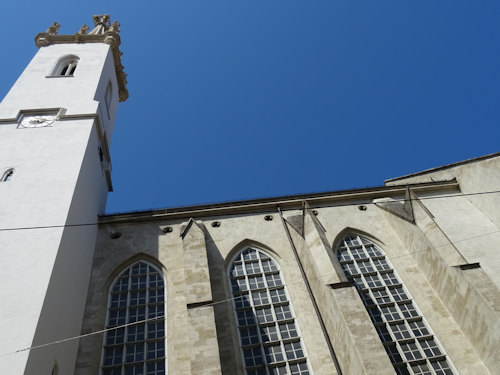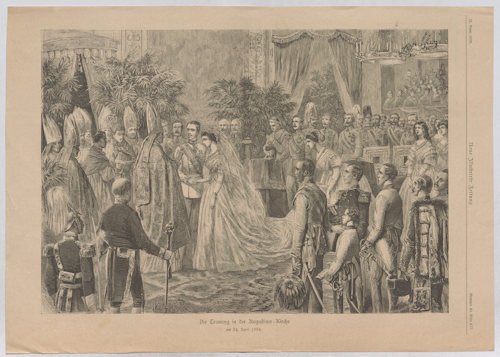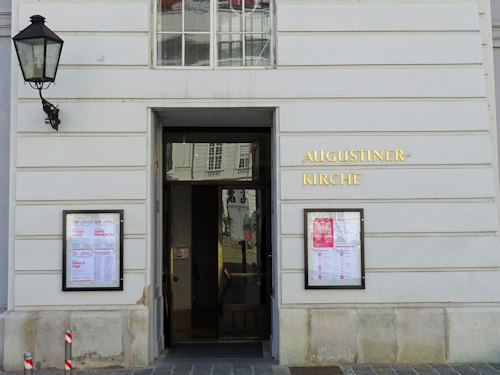
Sometimes unassuming walls hide long and colourful histories. And so it is with Vienna’s Augustinerkirche, the Habsburg monarchy’s court church for almost 300 years.
- Dates back to the 14th century
- Numerous Habsburg connections as a one-time court church
- Various monarchs married here
- Notable for organ recitals and other church music
- Anton Bruckner played here regularly
- Be sure to view the Canova memorial inside
- See also:
The Imperial Connection

(The façade spurns the decorative variety of many other city centre churches)
Vienna has a fair few old buildings, but the Augustinerkirche (Augustinian church) on Josefsplatz square is one of the oldest, dating back to 1327.
Frederick I (Duke of Austria and Styria) founded the church in what was, however, only his second-greatest achievement. His first was becoming known as Frederick the Handsome (seriously).
Of course, the church went through various changes in the intervening centuries and now merges gracefully into the surrounding Hofburg complex.
As such, the Augustinerkirche is not a self-contained landmark like Stephansdom cathedral.

(The Augustinerkirche in a 1724 copperplate drawn by Salomon Kleiner, engraved by Hieronymus Sperling and published by Johann Andreas d. Ä. Pfeffel; Wien Museum Inv.-Nr. 105765/14; excerpt reproduced with permission under the terms of the CC0 licence)
Instead, the building shares a near-continuous façade with the Albertina on one side and the extraordinary state hall and other offices of the National Library on the other.
The modest, unassuming appearance can mislead visitors, since the church is redolent with history.
From 1634 to 1918, for example, it served as the official court church for the Habsburg monarchs. The hearts of many of them rest in a crypt within the church walls.
Most famously, perhaps, the church played host to various royal weddings. Among the couples joined together beneath its roof:
- Emperor Franz Joseph and Elisabeth of Bavaria (1854)
- Crown Prince Rudolf and Stephanie of Belgium (1881)
- Empress Maria Theresa and Franz Stephan of Lorraine (1736)
- Archduchess Marie Louise and Napoleon Bonaparte (1810)
- Maria Antonia (Marie Antoinette) and King Louis XVI of France (1770)

(Vinzenz Katzler’s 1879 The Marriage in the Augustiner-Kirche on April 24th 1854 portraits the critical moment at the wedding of Franz Joseph and Elisabeth; Wien Museum Inv.-Nr. W 2565; reproduced with permission under the terms of the CC0 licence)
The last two weddings mentioned took place in the absence of the bridegroom (which was a thing in those days). For example, Napoleon asked Marie Louise’s uncle, Archduke Karl, to represent him.
The archduke later wrote to Napoleon to note that (my translation):
The celebratory role which your imperial majesty was kind enough to delegate to me was a particularly pleasant one
No doubt he got an extra slice of wedding cake for his trouble.

(The Sobieski plaque)
A plaque on an outer wall commemorates another famous event in the church’s history. The Polish King, Jan Sobieski, attended Mass in the Augustinerkirche after liberating Vienna from the Turkish siege of 1683.
Inside the Augustinian Church
Given its long history and association with the monastic Order of St Augustine (who manage the church), you find little of the ostentatious decoration you might be used to from the likes of Peterskirche, for example.
Some 700 years of architectural change and treasures are beyond my capabilities to describe, but two features stand out when inside the church.
The first is the marble memorial to Archduchess Marie Christine (1742-1798), sculpted by Antonio Canova and commissioned by her husband (Albert of Albertina fame), and completed in 1805.
Various symbolic figures form a funeral procession that seems to enter a darkened gateway to the underworld.

(A innocent gateway to the past)
The pews make up another intriguing feature, since they differ from each other quite significantly.
One set is relatively simple and unadorned. These seats apparently stem from the time of Emperor Joseph II (1741-1790), who disliked unnecessary pomp and circumstance.
Other pews have rich, detailed carvings and date back to before Joseph and his austerity philosophy.
Tickets & visitor tips
There’s no charge to enter the church (donations are obviously welcome), unless a concert is taking place.
Indeed, the Augustinerkirche has a strong reputation for its church music and not just in association with services, with fairly-regular organ recitals (such as during the summer organ festival).
The famous composer, Anton Bruckner, used to play the organ here in the late 1800s. That instrument now resides in Vienna’s Technical Museum last time I checked.
Note that this is a busy working church, so services may be on when you visit.
How to get to the Augustinerkirche
The church is about as central as you can get and so away from the tram lines that can only skirt the old town. The public entrance is on the Josefsplatz side. It’s an early stop on my suggested walking tour of the city centre.
Subway: take the U3 or U1 to Stephansplatz and walk along the Graben and up Dorotheergasse to reach the church
Bus: take the 2A to Albertinaplatz or the 1A to Habsburgergasse
Address: Augustinerstraße 3, 1010 Vienna | Website